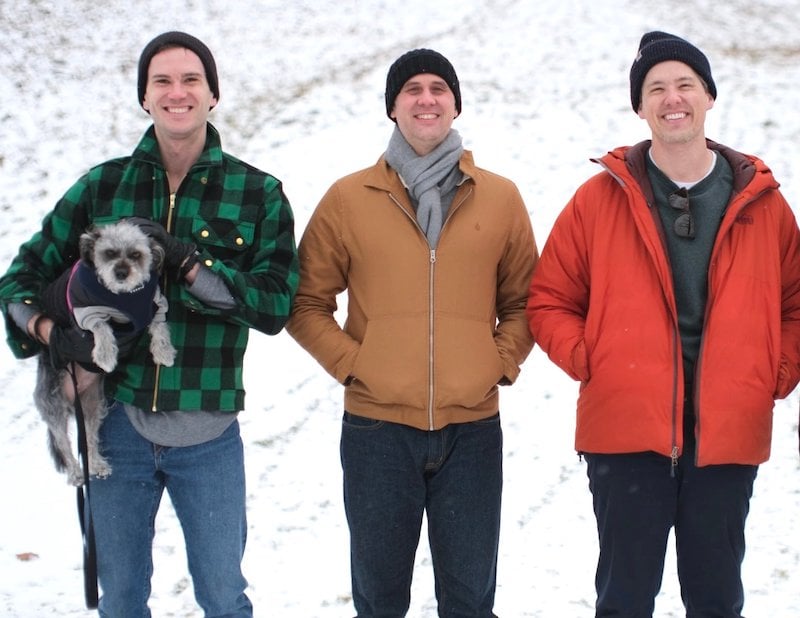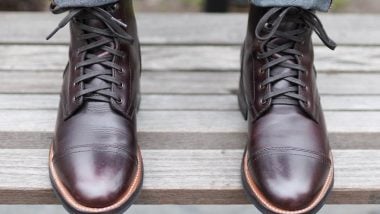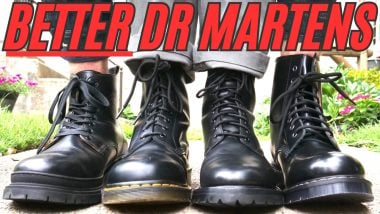A Beginner’s Guide to Horsehide Leather Boots

Expert Verified By: Michael Batson | Vice President: North Star Leather
The fact is that a lot of people still enjoy eating horsemeat — China, Mexico, and Russia are pretty big fans of the stuff.
What does this have to do with boots, you may ask? Without this, ah, delicacy, we wouldn’t have as much horsehide for making footwear. When every household had at least one horse, there was more horsehide to go around, and while the rise of the automobile eliminated that surplus, enough people eat horses that one can still find horse leather.
“The hides we use in American tanneries mainly come from French speaking Canada and Europe,” notes Michael Batson of North Star Leather Company.
Indeed, you’ll find that aficionados of the highest quality boots will often prefer it.
Is it really that good of a material? Get ready for a deep dive into the pros and cons of horsehide.

Limited Supply = High Prices
Boots made from horsehide can be expensive, and not just because it’s harder to come by than cowhide. (Thanks, beef industry.)
Less of the hide is suitable for mass production of leather, plus many of the more laborious methods of leather production are used on horse, with the best known example being shell cordovan — it can take over a year to make.

The Different Kinds of Horse Leather
The skin of any animal differs in thickness and density (compare your fingertips and your soles) and when it’s turned into footwear, it’s much more common for it to be made from the butt.
But you’ll sometimes find horsefront and strips — which is really close to the butt as well.

Shell Cordovan
Shell cordovan, often just called “cordovan,” is among the most prized and pricy kinds of leather — if you want to call it leather at all. It’s not made from skin. It’s made from a membrane just beneath the skin. Some say that means it isn’t leather, but others say if it’s a piece of animal that’s been tanned into a boot-ready material, then it’s leather. You decide!
“Shell I can actually come from any equine animal,” notes Batson. “Horse, mule, donkeys, they all have shells. Even zebra has been attempted.”
Shell has many rare properties: it’s self-shining, very vibrant, and it doesn’t crease — it instead forms “rolls” that cordovan fans go crazy for. The glossiness makes it good for dress shoes, but it’s also so hardwearing that it can make for a great pair of boots as well.
“It takes six to nine months to produce Cordovan leather from start to finish,” says Skip Horween, President of Horween Leather Company and grandson of its founder. “We move it through several stages, then let it rest — that’s always been part of the process. It’s worked for over a hundred years, and the temptation to do things faster has never been hard to ignore.”
“It’s also the most expensive generally available ‘leather’ on Earth,” says Batson, remembering that some folks insist it isn’t leather. “It’s usually over one hundred dollars per square foot.”
Made with a certain method of vegetable tanning, the process isn’t just time-intensive, and the hide isn’t just from an animal that’s hard to source, but you can only make it from a small area of the animal.
“Shells are usually produce just two square feet of material,” says Batson. “Each animal gives you two shells, but you’d be lucky to be able to produce two pairs of boots from one horse. You won’t find larger items made from it, like bags, because shells just aren’t that big. Even a cordovan belt is usually made from three pieces sewn together.”
All of this makes cordovan remarkably expensive — while there are some exceptions, you should usually expect to pay four figures for cordovan boots.
Further Reading
A Tannery Explains How Shell Cordovan Is Made
We visited Horween Leather Company in Chicago to explore the year-long process of making their shell. Learn more →
Horsebutt / Horserump
Horsebutt is also made from the horse’s butt. The difference is that horsebutt is made from all three layers of the butt (grain, shell, and flesh) while shell is just, well, the “shell” under the skin.
“Horsebutt contains Shell cordovan, so all Shell is horsebutt, but not all horsebutt is Shell,” explains Dale Basista of Dale’s Leatherworks.
Horsebutt isn’t quite as difficult to make as cordovan, though it’s usually vegetable tanned, which is a more expensive way to make leather.

Again, horsebutt is exalted by boot enthusiasts. When I visited Indonesia to explore their boot scene, all three makers I visited said that the majority of their American customers ordered horsebutt boots.
Cordovan isn’t all that thick, but you can find horsebutt boots with leather a good three millimeters thick. It’s usually vegetable tanned, which adds to the incredible stiffness, but folks love how tough they feel and how beautifully they age.

Horse Strips
“Strips are sh*t cut off from the edges of butts,” says the always profane Vince Romano of Truman Boot Company.
Positioned between the horse’s front and the shells (some call it “north of cordovan”), horse strips are odd-shaped pieces of leather. Their thickness can fluctuate dramatically on the same hide, and it’s easy to make horse trips that are too tough and stiff to do much of anything with.
“One bootmaker told me he uses horse strips for the tongues because it’s cheap and nobody gives a sh*t about the tongue,” Dale chimed in on the group chat.
But it still has its uses. Horse strips have a dense and tight fiber structure that’s good for molding, and you’ll sometimes find it used for holsters, belts, and small leather goods.
[Very relevant: Why Is Cordovan Leather So Damn Expensive?]

Horsefronts
The front of the hide is relatively thin, so it’s less commonly found on footwear.
“Horween’s Front Quarter Horsehide is great for jackets, but definitely not even enough grain for a nice boot,” says Dale.
“Horsefronts” are lightweight and have a great tensile strength, so they’re traditionally used in leather jackets, wallets, card holders, and other products made of thin leather that need a good ratio of strength and weight.
There are exceptions: Viberg released Crust Horsehide Service Boot made of horsefront and horsebutt.

While “too thin for boots” might make you think it’s a crummy leather, you should know that horsehide isn’t just common on jackets: it’s universally considered the best leather for high-quality leather jackets.
Note that perhaps the most popular leather for casual boots is Chromexcel, made by Chicago’s Horween Leather Company. They use the same process for making Front Quarter Horsehide Chromexcel, which is one of the most popular leathers for high end jackets.
Check out our video below on a range of Japanese leather jackets, most of which are made from horsefront.
Horsehide Is Durable
Let’s talk about the benefits of horsehide.
All skin has collagen fibers. The fibers in the horse’s rear are more compressed than in steer hide, which is one reason Shell Cordovan doesn’t crack or crease. The grain structure also means that horsehide tends to be more abrasion-resistant than cowhide.
While most kinds of horsehide can be made as thick as a regular steerhide boot leather, horsebutt can be seen used in weights over 50 percent higher than, say, a Red Wing Heritage boot. Such extra-thick horsehide is popular among serious enthusiasts of high-end boots: here’s Adi of Briselblack Bootmakers explaining.
Horsehide Looks Great
Compared with cattle, horses live pampered lives. You won’t see the scars from barbed wire or mistreatment. Horsehide leather almost always has a consistent appearance across its surface. This uniformity gives a refined look. Shells have little to no visible grain, allowing the cordovan tanning process to reveal a beautiful shine. Strips have a pronounced grain that becomes accentuated with a lovely veg tan and oil finish. The hide has a more natural appearance because horses live longer than cows.
On the surface, horsehide doesn’t seem all that suitable for boots. A lot of the hide is too thin or too thick, resulting in a leather that’s too fragile. It’s in limited supply, it’s expensive, and requires extra time and effort to produce quality boots. Yet, the best bootmakers of our generation keep using it to craft amazing products.
Horsehide requires appropriate tanning and great craftsmanship to highlight its best qualities, and its unique look sets it apart from more common leathers, and its durability means it may shine on for longer than you’ll be around to enjoy it.
Featured image via @vibergboot on Instagram.











“Compared with cattle, horses live pampered lives. You won’t see the scaring from barbed wire or mistreatment. ”
The horses sent to slaughter plants in Mexico are by no means “pampered.” They are abandoned at feed lots or unwittingly sold to killer-buyers by owners under financial duress.
They are loaded into cattle trailers and driven across the border. Horses, being more reactive than cattle, are often shot in the eyeball with a pellet gun to keep them from kicking each other on the torturous journey.
These horses are certainly mistreated, and any assertion that they are not is a blatant lie.
Yeah the author meant relative to the massive factory farms so popular for cows, horses have better lives. A gun in the eye is *relatively* better than torturous travel but to be sure, no animal that’s slaughtered has been treated humanely.
Is there any evidence that US, European or Japanese tanneries source their horsehides from Mexico?
I dont know! The supply chain is often a bit murky for horsehide.
Slaughtering horses for meat and leather became illegal in the US around 1960. A leather tanner in the US has to wait for the horse to die a natural death or be put down. It makes sense to use the hide for leather.
Are you sure? Seems to be legal, just frowned upon: https://en.wikipedia.org/wiki/Horse_slaughter#Legal_proceedings
I have been trying to find something on Horsehide care. I find so much on shell that its overlooked in my opinion. How should I care for horsehide leather boots? Should I treat it like a cowhide boot or like shell cordovan in terms of cleaning and conditioning?
Just treat it like cowhide, really. Some Venetian Shoe Cream now and then after cleaning with a wet rag or a gentle leather cleaner like Cobbler’s Choice.